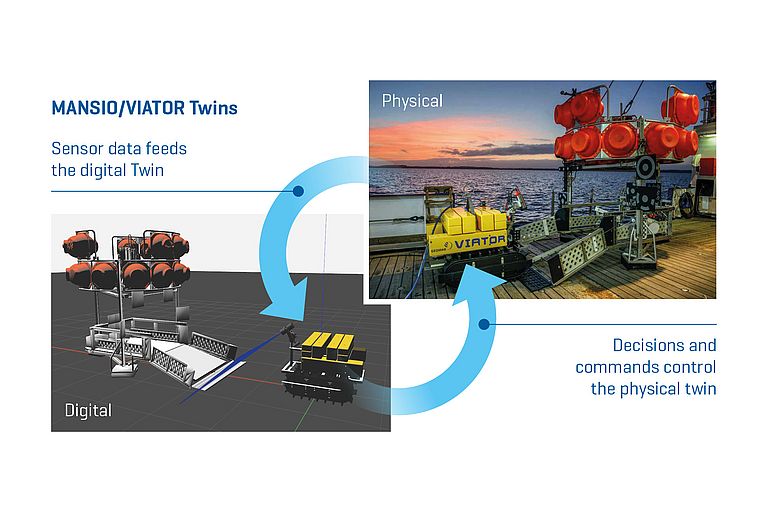Awards for plankton imaging system and digital twins
GEOMAR honours new and innovative methods in marine research
Monitoring the ocean and the organisms which live in it is one of the great challenges to be met by modern ocean science. Only if we know about the processes taking place in the ocean, we will be able to detect changes, assess their consequences and potentially take countermeasures or adapt our policies.
Appropriately, with the 2020 Innovation Awards – the presentation of which, due to the Corona Pandemic, had to be postponed to this year – the GEOMAR technology transfer office is honouring two projects which may bring key advancements to ocean monitoring. “I warmly congratulate the winners on their great work and ideas, which have already attracted interest outside GEOMAR”, says Dr. Warner Brückmann, head of the technology transfer office.
The projects which have been awarded are:
'All-in-focus' plankton imaging system
To the naked eye, plankton is barely visible. It consists out of microscopically small organisms, some of which are very fragile. Even today, examinations of plankton in the ocean are mostly carried out just like they were 100 years ago – by catching specimens in nets and then performing time-consuming microscopical analyses. For some years, however, scientists have been using underwater camera systems to document plankton organisms in their natural habitat. Yet, image-based analysis of these microscopic creatures still bears a lot of challenges: On the one hand, optical methods that are fit for classification of plankton will require a very high resolution (optical enlargement), which entails a drastic reduction of the depth of field. On the other hand, as concentrations of plankton in the ocean are often very low, plankton monitoring requires large sampling volumes. This, however, calls for a good depth of field.
Working within the GEOMAR junior research group “Plankton Imaging“, Jan Taucher and his colleagues Anton Theileis, Veit Dausmann and Lars Jurkat from the GEOMAR Research Centre for Ocean Research Kiel succeeded in developing an optical method to take high-resolution images of plankton with a very large depth of field. For this purpose, the team’s ‘all-in-focus’ plankton imaging system combines novel high-speed liquid lenses with a special optical imaging technique. The newly developed plankton camera system brings a great advance in imaging quality and sample volume and thus enables scientists to study plankton in much greater detail than previously possible.
The instrument was successfully deployed for the first time during a research cruise off the Norwegian coast at the beginning of this year. In the upcoming years, it will be used to collect high-quality data on the distribution of plankton in the oceans. This innovation is already protected as a utility model, a patent is pending.
Digital Twins Framework
Working within the Helmholtz Future Topic project ARCHES (Autonomous Robotic Networks to Help Modern Societies), Alexander Barbie and Niklas Pech from the GEOMAR Helmholtz Centre for Ocean Research Kiel in collaboration with the Alfred Wegener Institute Helmholtz Centre for Polar and Marine Research (AWI) created a software framework for developing and running digital twins. Digital twins are an approach which was taken from the internet of things, to which they are a further extension. A digital twin is a digital model of an object that physically exists, e.g. a deep sea tool or even a whole ocean bottom monitoring system. The digital twin reflects the status or the processes of the physical twin and records the development of the physical twin through time.
More practically said, this means that an ocean bottom monitoring system that is deployed under water is connected with its corresponding digital model which is located on a ship, and that there is a regular exchange of data. Thus, scientists will be able to check sensor data and the status of an ocean bottom monitoring system any time from the ship, and that possible scenarios can be tested on the digital twin before commands are sent to the physical system. Furthermore, using artificial intelligence, tasks which consume a lot of energy such as analyses and prognoses can be relocated from the ocean bottom monitoring system to the digital twin for faster and less energy-consuming calculation.
The whole framework is based on open source technologies. It was successfully tested in October 2020 in the Bocknis Eck (Eckernfoerde Fjord) working area. Here, for the first time, a hydroacoustic, cordless, cooperating network of several ocean bottom monitoring systems run by GEOMAR and AWI was established.
“I am very pleased about the highly innovative developments achieved by those two working groups“, says Professor Dr. Katja Matthes, Director of GEOMAR. “Innovative technical solutions are, on the one hand, important drivers for advancements in marine science. On the other hand, they offer opportunities for the transfer of this technology to commercial usability”, Matthes continues.
Background:
The GEOMAR Innovation Awards were launched in 2018. They were created to honour outstanding technical innovations which have a lasting effect on GEOMAR's scientific work. There are two categories: single inventor and team. Focus is put on truly original ideas as well as the possibility of utilization in the context of technology transfer. Each of the awards carries a value of € 6.000.





